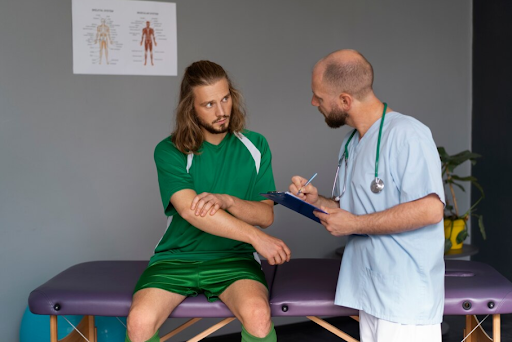In the world of sports, injuries are an unfortunate reality that athletes must navigate. Whether you’re a professional or a weekend warrior, understanding effective strategies for sports injury treatment is crucial to recovery and long-term success. Here’s a comprehensive guide on top strategies for managing sports injuries, helping you stay on the path to peak performance.
1. Immediate Care: The R.I.C.E. Method
When an injury occurs, the immediate response can significantly influence the recovery process. The R.I.C.E. method—Rest, Ice, Compression, and Elevation—is a foundational approach in sports injury treatment.
- Rest: Avoid putting weight or stress on the injured area to prevent further damage. Rest allows the body to start the healing process without additional strain.
- Ice: Applying ice to the injury reduces swelling and numbness. Aim for 20 minutes of icing every hour during the initial 48 hours post-injury.
- Compression: Use an elastic bandage to apply gentle pressure to the injury. This helps control swelling and supports the injured area.
- Elevation: Keep the injured limb elevated above heart level to help reduce swelling and facilitate fluid drainage from the affected area.
2. Professional Assessment: Seek Medical Attention
While R.I.C.E. can provide initial relief, seeking professional medical assessment is crucial for a thorough diagnosis. An orthopedic specialist, sports medicine doctor, or physiotherapist can provide an accurate diagnosis and tailor a treatment plan based on the specific injury. They may recommend imaging tests, such as X-rays or MRIs, to determine the extent of the damage.
3. Rehabilitation and Physical Therapy
Rehabilitation plays a vital role in sports injury treatment, aiming to restore function and strength to the injured area. A physical therapist can design a customized rehab program that includes exercises to improve flexibility, strength, and balance. The goal is to help athletes return to their sport safely and efficiently.
Key elements of a rehabilitation program may include:
- Strength Training: Focus on strengthening muscles around the injured area to provide better support and prevent future injuries.
- Range of Motion Exercises: Enhance flexibility and reduce stiffness to regain full movement capability.
- Functional Training: Reintroduce sport-specific movements to ensure the athlete can perform at their best when they return to play.
4. Pain Management Techniques
Managing pain effectively is an integral part of sports injury treatment. Various methods can help alleviate discomfort and support recovery:
- Medications: Over-the-counter pain relievers like ibuprofen or acetaminophen can help manage pain and reduce inflammation.
- Heat Therapy: Applying heat can help relax tight muscles and improve blood flow to the area, particularly in the later stages of recovery.
- Alternative Therapies: Techniques such as acupuncture, massage therapy, and chiropractic care may offer additional relief and aid in the healing process.
5. Gradual Return to Activity
Returning to sports too soon can risk re-injury or worsen the condition. It’s essential to follow a gradual return-to-activity plan, which involves:
- Progressive Loading: Start with low-intensity exercises and gradually increase the intensity as tolerated. This approach helps assess readiness and prevents setbacks.
- Monitoring Symptoms: Pay close attention to any signs of pain or discomfort during activity. If symptoms worsen, it may be necessary to scale back and seek further evaluation.
6. Preventative Measures
Prevention is key to avoiding future injuries. Incorporate the following strategies into your routine to reduce the risk of injury:
- Warm-Up and Cool-Down: Proper warm-up and cool-down routines prepare your body for activity and aid in recovery.
- Proper Technique: Ensure correct form and technique in your sport to minimize the risk of injury. Working with a coach or trainer can help refine your skills.
- Cross-Training: Engage in various forms of exercise to build overall strength and flexibility, reducing the likelihood of overuse injuries.
7. Nutrition and Hydration
A well-balanced diet and proper hydration are fundamental components of sports injury treatment and recovery. Nutrients like protein, vitamins, and minerals support tissue repair and overall health. Staying hydrated helps maintain joint lubrication and muscle function.
Conclusion
Effective sports injury treatment requires a multifaceted approach, combining immediate care, professional assessment, rehabilitation, pain management, and preventative measures. By understanding and applying these strategies, athletes can enhance their recovery and return to their sport with greater resilience and strength. Prioritizing these aspects not only aids in effective treatment but also promotes long-term athletic success.

